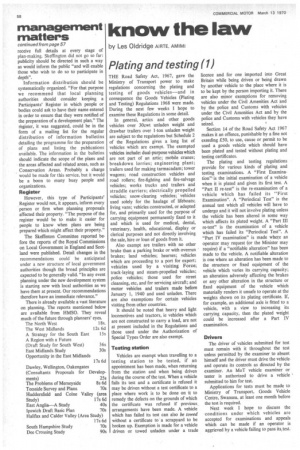know the law
Page 60

If you've noticed an error in this article please click here to report it so we can fix it.
by Les Oldridge AIRTE. AMIMI
Plating and testing (1)
THE Road Safety Act, 1967, gave the Ministry of Transport power to make regulations concerning the plating and testing of goods vehicles—and in consequence the Goods Vehicles (Plating and Testing) Regulations 1968 were made. During the next few weeks I hope to examine these Regulations in some detail.
In general, artics and other goods vehicles over 30cwt unladen weight and drawbar trailers over 1-ton unladen weight are subject to the regulations but Schedule 2 of the Regulations gives a long list of vehicles which are exempt. The exempted vehicles include: dual-purpose vehicles which are not part of an artic; mobile cranes; breakdown lorries; engineering plant; trailers used for making tarmacadam; tower wagons; road construction vehicles and road rollers; fire-fighting and fire-salvage vehicles; works trucks and trailers and straddle carriers; electrically propelled vehicles; snow-clearing vehicles; vehicles used solely for the haulage of lifeboats; living vans; vehicles constructed, or adapted for, and primarily used for the purpose of carrying equipment permanently fixed to it and which is used for medical, dental, veterinary, health, educational, display or clerical purposes and not directly involving the sale, hire or loan of goods from it.
Also exempt are trailers with no other brake than a parking brake or with overrun brakes; land vehicles; hearses; vehicles which are proceeding to a port for export; vehicles used by a visiting Force; track-laying and steam-propelled vehicles; police vehicles; those used for street cleansing, etc, and for servicing aircraft; and motor vehicles and trailers made before January 1, 1940 and used unladen. There are also exemptions for certain vehicles visiting from other countries.
It should be noted that heavy and light locomotives and tractors, ie vehicles which are not constructed to carry a load, are not at present included in the Regulations and those used under the Authorization of Special Types Order are also exempt.
Testing station
Vehicles are exempt when travelling to a testing station to be tested, if an appointment has been made, when returning from the station and when being driven during the course of the test. When a vehicle fails its test and a certificate is refused it may be driven without a test certificate to a place where work is to be done on it to remedy the defects on the grounds of which the certificate was refused if previous. arrangements have been made. A vehicle which has failed its test can also be towed without a certificate to a scrapyard to be broken up. Exemption is made for a vehicle driven or towed unladen under a trade
licence and for one imported into Great Britain while being driven or being drawn by another vehicle to the place where it is to be kept by the person importing it. There are also minor exemptions for removing vehicles under the Civil Amenities Act and by the police and Customs with vehicles under the Civil Amenities Act and by the police and Customs with vehicles they have seized.
Section 14 of the Road Safety Act 1967 makes it an offence, punishable by a fine not exeecling £50, to use, cause or permit to be used a goods vehicle which should have been plated and tested without plating and testing certificates.
The plating and testing regulations provide for various kinds of plating and testing examinations. A "First Examination" is the initial examination of a vehicle when it is plated and given its first test. A "Part II re-test" is the re-examination of a vehicle which has failed its "First Examination". A "Periodical Test" is the annual test which all vehicles will have to undergo and it will not involve plating unless the vehicle has been altered in some way which affects its plated weight. A "Part III re-test" is the examination of a vehicle which has failed its "Periodical Test". A "Part IV examination" is made where an operator may request (or the Minister may require) if a "notifiable alteration" has been made to the vehicle. A notifiable alteration is one where an alteration has been made to the structure or fixed equipment of the vehicle which varies its carrying capacity; an alteration adversely affecting the brakes or any other alteration in the structure or fixed equipment of the vehicle which materially renders it unsafe to operate at the weights shown on its plating certificate. If, for example, an additional axle is fitted to a vehicle, with a view to increasing its carrying capacity, then the plated weight could be increased after a Part IV examination.
Drivers
The driver of vehicles submitted for test must remain with it throughout the test unless permitted by the examiner to absent himself and the driver must drive the vehicle and operate its controls as directed by the examiner. An MoT vehicle examiner or tester is authorized to drive a vehicle submitted to him for test.
Applications for tests must be made to Ministry of Transport, Goods Vehicle Centre, Swansea, at least one month before the test is required.
Next week I hope to discuss the conditions under which vehicles are accepted for examinations and appeals which can be made if an operator is aggrieved by a vehicle failing to pass its.test.




























































































